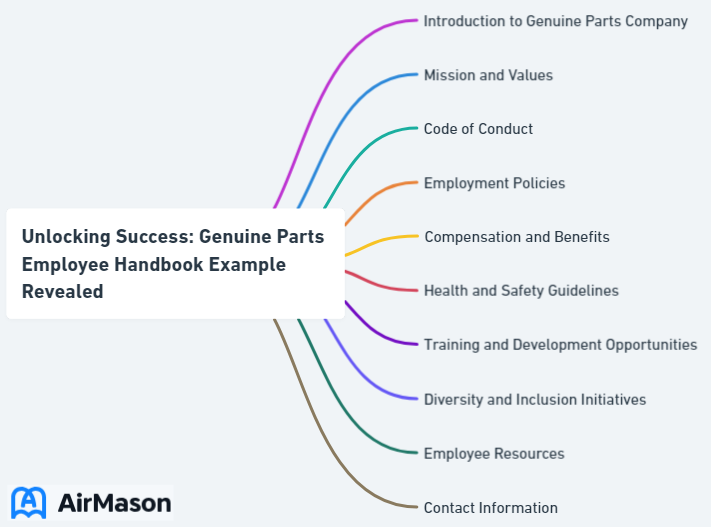
Employee handbooks are essential assets in ensuring employees comprehend the company culture, policies, and benefits. A well-crafted employee handbook can significantly impact employee engagement and satisfaction, ultimately contributing to the overall success of the organization. One outstanding example in the world of employee handbooks is the “genuine parts employee handbook example”. This comprehensive guide serves as a model for other companies looking to create or enhance their employee handbooks.
Throughout this blog post, we will examine the genuine parts employee handbook example and uncover the key elements that make it effective. From its emphasis on company culture to its clear communication of policies and visually appealing design, Genuine Parts exemplifies how an employee handbook can be a powerful tool for aligning employees and fostering a positive work environment.
By the end of this blog post, you will understand the importance of employee handbooks and gain insights into creating a winning employee handbook that caters to your company’s unique needs and challenges. You will also learn how to adapt your own handbook for industry-specific requirements and compare the genuine parts employee handbook example to other notable examples for inspiration and best practices.
Key Takeaways
- Genuine Parts’ Employee Handbook emphasizes company culture and values to foster an engaging work environment.
- It effectively outlines policies, procedures, benefits & compensation programs for clarity & consistency.
- Strategies such as clear communication and visually appealing design can help create a successful guide for employees.
Employee Handbook Examples
In exploring effective workplace guidelines, it is crucial to examine various employee handbook examples. “Employee handbook examples” serve as valuable templates for organizations seeking to establish comprehensive policies and procedures. These documents encapsulate the company’s values, code of conduct, and expectations, providing a clear roadmap for both employers and employees. By delving into diverse employee handbook examples, businesses can tailor their own guidelines to align with industry standards and unique organizational cultures. These examples offer insights into best practices, ensuring that companies can create a resourceful and inclusive guide that fosters a positive and productive work environment.
Dissecting Genuine Parts’ Employee Handbook
An employee handbook is a comprehensive guide outlining the company’s policies, procedures, and benefits for existing employees. It serves as a communication tool, assisting employees in understanding the company and its policies, as showcased in various employee handbook examples. Moreover, an effective employee handbook should:
- Articulate the core values, regulations, processes, and corporate ethos in straightforward yet captivating language
- Act as an onboarding aid for new employees
- Serve as a reference guide for current staff
Next, we will analyze Genuine Parts’ Employee Handbook to understand how it successfully conveys company culture, policies, and benefits. We will explore the company’s culture and values, policies and procedures, and benefits and compensation, providing insights into the components that make this handbook exceptional.
Recognizing the significance of a well-structured employee handbook is integral to promoting employee awareness and participation. Having an effective employee handbook can set forth clear expectations and foster a positive workplace culture. Analyzing Genuine Parts’ Employee Handbook provides us with useful information on how to create a captivating and informative guide for our own organizations.

Company Culture and Values
One of the most significant aspects of Genuine Parts’ Employee Handbook is its emphasis on company culture and values. The handbook conveys the company’s dedication to upholding human rights in all its locations of operation and highlights core values such as:
- Staying authentic
- Embodying the company’s values
- Acting with integrity towards each other and customers
- Cultivating trust-based relationships with stakeholders
Emphasizing sound business practices, authenticity, and integrity in its employee handbook allows Genuine Parts to effectively communicate its company culture to its employees. This focus on company culture helps employees feel tied to and aligned with the organization’s values, contributing to a more engaged and productive workforce.
Genuine Parts’ approach to showcasing its company culture and values in its employee handbook sets the tone for employee expectations and behavior. This emphasis on culture and values not only helps employees understand what the company stands for but also fosters a work environment that encourages collaboration, mutual respect, and overall success.
Policies and Procedures
Policies and procedures in an employee handbook serve an essential purpose:
- To ensure clarity and consistency
- To provide employees with a reference point to understand their employment rights and adhere to company guidelines
- To minimize confusion and potential conflicts
- To make the workplace more efficient and harmonious.
Genuine Parts’ Employee Handbook clearly outlines its policies and procedures, covering various aspects such as:
- Employment basics
- Workplace policies
- Code of conduct
- Compensation and development
- Benefits and perks
- Working hours
- PTO and vacation
- Employee resignation and termination
By incorporating a comprehensive code of conduct, Genuine Parts ensures a productive and harmonious workplace while averting potential disputes.
An employee handbook that effectively addresses policies and procedures is crucial for maintaining a positive work environment. Genuine Parts’ Employee Handbook is an excellent example of how to clearly outline policies and procedures, ensuring employees understand their responsibilities and rights, and fostering a workplace where everyone is on the same page.
Benefits and Compensation
A vital component of any employee handbook is the information on benefits and compensation. By providing comprehensive details on these aspects, Genuine Parts’ Employee Handbook promotes transparency and employee satisfaction, ensuring that all employees are aware of their entitlements and the advantageous opportunities they have access to.
Genuine Parts’ employee handbook outlines a range of benefits, including:
- Medical, dental, and vision insurance
- HSA and FSA accounts
- Life and AD&D insurance
- Disability plans
- 401(k) plan with matching
- Paid time off
- Tuition assistance
This extensive list of benefits not only helps employees understand their compensation package but also showcases the company’s dedication to employee well-being and satisfaction.
The Compensation and Human Capital Committee plays a key role in overseeing the company’s compensation and benefits programs. This committee is responsible for designing, implementing, and administering the company’s compensation and benefits plans, as well as reviewing and approving the company’s compensation and benefits policies and procedures. By providing detailed information on benefits and compensation, Genuine Parts’ Employee Handbook ensures transparency and promotes a positive work environment.
Crafting a Winning Employee Handbook: Lessons from Genuine Parts

Now that we have dissected Genuine Parts’ Employee Handbook, we can extract valuable lessons to apply to our own employee handbooks. As we analyze the handbook’s emphasis on company culture, clear communication, and visual appeal, we begin to understand the importance of these aspects in creating an engaging and informative guide for employees.
Next, we will further analyze these lessons from Genuine Parts’ Employee Handbook and how emphasizing company culture, clear communication, and appealing design can enhance your own employee handbook. By understanding and applying these lessons, you can create an employee handbook that effectively communicates your company’s culture, policies, and benefits, ultimately fostering employee engagement, satisfaction, and success.
Emphasizing Company Culture
One of the key lessons from Genuine Parts’ Employee Handbook is the importance of emphasizing company culture in your own handbook. By showcasing your unique culture and values, you can help employees feel connected and aligned with your organization’s values, ultimately leading to a more engaged and productive workforce.
Genuine Parts effectively showcases its company values and the company’s dedication in its employee handbook by emphasizing its company’s values such as:
- Integrity
- Ethical behavior
- Honesty
- Teamwork
- Inclusivity
- Mutual respect
- Community
- Communication
- Courage
This sets the tone for employee expectations and behavior, promoting a work environment that encourages collaboration and success.
To apply this lesson to your own employee handbook, consider incorporating your company’s core values, mission statement, and unique aspects of your workplace culture. This emphasis on company culture can help employees understand what your organization stands for and fosters a work environment where everyone is engaged and aligned with your company’s values.
Clear Communication
Another essential lesson from Genuine Parts’ Employee Handbook is the importance of clear communication. A well-written employee handbook should be easy to understand and provide employees with the information they need to succeed in their roles. Clear communication ensures that employees understand the expectations and policies set forth by the company, reducing confusion and potential conflicts.
Genuine Parts employs a variety of strategies to ensure effective communication in its employee handbook, such as:
- Establishing clear expectations
- Providing comprehensive instructions
- Utilizing plain language
- Encouraging feedback and open dialogue
By doing so, they create a handbook that is accessible and easy for employees to navigate, ensuring they have the information they need to succeed in their roles.
To apply this lesson to your own employee handbook, focus on clear communication in your writing. Ensure that your handbook’s language is straightforward and concise, making it easy for employees of all backgrounds and experience levels to understand. Additionally, consider incorporating visuals or interactive elements to further enhance the clarity and accessibility of the information.
Sherwin-Williams Employee Handbook Example
In the Sherwin-Williams employee handbook example, our commitment to fostering a positive and inclusive work environment is exemplified. The Sherwin-Williams employee handbook not only outlines the company’s policies and procedures but also serves as a comprehensive guide for our valued employees. Within the Sherwin-Williams employee handbook example, you will find clear and concise information regarding workplace expectations, benefits, and the shared values that form the foundation of our corporate culture. We believe that a well-crafted employee handbook is instrumental in promoting a harmonious and productive workplace, and the Sherwin-Williams example stands as a testament to our dedication to creating a supportive and thriving work community.
Visual Appeal
The final lesson from Genuine Parts’ Employee Handbook is the importance of visual appeal in creating an engaging and memorable guide. Incorporating visually appealing design elements into your employee handbook can make it easier to read and navigate, ultimately increasing employee engagement and satisfaction.
Genuine Parts’ employee handbook incorporates design elements such as aesthetically pleasing layouts, graphics, and typography to enhance its visual appeal. These design choices not only make the handbook more enjoyable to read but also help to capture and maintain the reader’s interest.
To apply this lesson to your own employee handbook, consider incorporating visually appealing design elements such as color schemes, images, and infographics. Additionally, ensure that your handbook has a clear and consistent layout, with headings, subheadings, and a user-friendly table of contents to help readers easily locate the information they need.
Adapting Your Employee Handbook for Industry-Specific Needs

Adapting your employee handbook for industry-specific needs is crucial for legal compliance and addressing the unique challenges faced by your organization. By tailoring your handbook to your industry’s specific requirements, you can ensure that your employees have the guidance and support they need to succeed in their roles.
Next, we will focus on the significance of legal compliance and tackling unique challenges in your employee handbook. By considering these aspects, you can create a handbook that is catered to the specific needs of your industry and your employees.
Incorporating industry-specific needs and legal compliance into your employee handbook not only protects your company and employees but also helps to create a more comprehensive and informative resource for your workforce.
Legal Compliance
Ensuring that your employee handbook complies with industry-specific laws and regulations is essential for protecting your company and employees. Legal compliance includes adhering to all applicable laws, rules, and regulations, which can help safeguard your business and personnel from potential legal liabilities.
Genuine Parts requires employees to comply with all applicable legal requirements, even if they are not specifically addressed in the handbook. Additionally, they may have additional policies and procedures in place to ensure legal compliance.
Staying apprised of legal changes relevant to your industry can be achieved by:
- Subscribing to industry-specific newsletters and publications
- Attending industry conferences and webinars
- Consulting legal professionals
- Utilizing online resources
By incorporating legal updates and industry-specific requirements into your employee handbook, you can ensure that your organization remains compliant and protects both your company and your employees.
Addressing Unique Challenges
In addition to legal compliance, it is essential to address the unique challenges faced by your industry in your employee handbook. Providing guidance and support for employees in facing industry-specific challenges can help them succeed in their roles and contribute to the overall success of your organization.
For example, the automobile parts industry faces challenges such as manual handling, adapting to changing conditions, and addressing supply chain issues. Incorporating guidelines and policies related to these challenges in your employee handbook can provide employees with the support they need to overcome these obstacles and excel in their roles.
By tailoring your employee handbook to address the unique requirements and challenges of your industry, you can create a more comprehensive and informative guide for your employees. This focus on industry-specific needs can help ensure that your employees have the resources and support they need to succeed in their roles and contribute to your organization’s success.
Comparing Genuine Parts’ Employee Handbook with Other Notable Examples

Comparing Genuine Parts’ Employee Handbook with other notable examples can provide insights into industry best practices and innovative approaches to handbook design. By analyzing how other successful companies communicate their company culture, policies, and benefits, you can gain valuable knowledge to apply to your own handbook.
Next, we will contrast Genuine Parts’ Employee Handbook with other significant examples, focusing on industry leaders and innovative handbook design approaches. By examining these different examples, you can gain a deeper understanding of what makes an effective employee handbook and how to create a guide that is engaging, informative, and catered to your industry’s unique needs.
This comparison will not only showcase the variety of approaches to employee handbook design but also highlight the importance of creating a handbook that is engaging, informative, and reflective of your organization’s culture and values.
Industry Leaders

Analyzing industry leaders’ employee handbooks can provide valuable insights into what makes them effective and how they communicate their company culture, policies, and benefits. For example, Airbnb’s employee handbook is characterized by a warm, approachable, and well-branded aesthetic, while Google’s handbook outlines policies, procedures, and expectations, emphasizing their commitment to workplace culture and providing information on their core values and house rules.
These industry leaders showcase how a well-designed employee handbook can effectively communicate company culture, policies, and benefits, ultimately fostering employee engagement, satisfaction, and success. By examining these industry leaders’ handbooks, you can gain insights into best practices in handbook design and communication.
Understanding how industry leaders craft their employee handbooks can help you refine and improve your own handbook. Incorporating similar design elements and communication strategies can enhance your handbook’s effectiveness, ultimately contributing to a more engaged and satisfied workforce.
Innovative Approaches
Exploring innovative approaches to employee handbook design can inspire you to create a more engaging and memorable guide for your employees. Examples of innovative approaches include incorporating humor, storytelling, or interactive elements to capture and maintain the reader’s interest.
For instance, Valve’s employee handbook employs humor to engage employees and create a more positive work environment, while Netflix’s employee handbook comprises 129 slides that outline the company’s culture and policies in a visually appealing, easy-to-navigate format.
By examining these innovative approaches to employee handbook design, you can gain inspiration and ideas to enhance your own handbook. Incorporating elements such as humor, storytelling, or interactive features can make your handbook more engaging and memorable, ultimately contributing to a more satisfied and engaged workforce.
Tips for Regularly Updating Your Employee Handbook

Regularly updating your employee handbook is essential to ensure legal compliance and reflect company growth and changes. By keeping your handbook up-to-date, you can provide employees with accurate and current information, ensuring that they have the resources and support they need to succeed in their roles.
Next, we will provide tips for routinely updating your employee handbook, with a focus on legal updates and company growth and changes. By implementing these tips, you can maintain a comprehensive and informative employee handbook that effectively communicates your company’s culture, policies, and benefits.
Regular updates to your employee handbook not only protect your organization and employees but also help to create a more comprehensive and informative resource for your workforce.
Legal Updates
Staying up-to-date with legal updates and incorporating them into your employee handbook is essential for maintaining compliance and protecting your organization. Regularly reviewing and updating your handbook to reflect changes in employment laws can help safeguard your business and personnel from potential legal liabilities.
To effectively communicate legal updates in your employee handbook, it is important to:
- Regularly review and update the handbook
- Communicate policy changes often and transparently to employees
- Involve management in the revision process
- Provide reasons behind policy updates
By staying informed of legal changes relevant to your industry and incorporating these updates into your handbook, you can ensure compliance and protect both your company and your employees.
Implementing these tips for staying informed of legal updates and incorporating them into your employee handbook can help you maintain a comprehensive and informative guide that effectively communicates your company’s culture, policies, and benefits.
Company Growth and Changes
Updating your employee handbook to reflect company growth and changes is essential to ensure employees have accurate and current information. By incorporating changes in operations, employee numbers, new products or services, mergers or acquisitions, or shifts in company culture, you can provide employees and new hires with the resources and support they need to succeed in their roles.
To amend your employee handbook as company policies evolve, consider the following steps:
- Routinely review the handbook to ensure that policies accurately mirror current situations and are understandable.
- Set a timeline for updates to keep the handbook up to date.
- Designate roles and responsibilities for the revision process to ensure accountability.
- Track and document changes made to the handbook for future reference.
- Distribute the revised handbook to employees to ensure they have the most current information.
By updating your employee handbook to reflect company growth and changes, you can provide employees with accurate and current information, ultimately fostering a more engaged and satisfied workforce.
Summary
Throughout this blog post, we have explored the importance of employee handbooks and examined Genuine Parts’ Employee Handbook as an outstanding example. We have dissected the handbook to understand its effectiveness in communicating company culture, policies, and benefits, and analyzed the lessons that can be applied to your own employee handbook.
By emphasizing company culture, ensuring clear communication, and creating visually appealing design, you can craft an employee handbook that effectively communicates your company’s culture, policies, and benefits, ultimately fostering employee engagement, satisfaction, and success. Additionally, adapting your employee handbook for industry-specific needs and regularly updating it to reflect legal compliance and company growth and changes will ensure that your handbook remains a comprehensive and informative resource for your workforce.
In conclusion, a well-crafted employee handbook is an essential asset for any organization. By applying the lessons and insights gained from Genuine Parts’ Employee Handbook and other notable examples, you can create a winning employee handbook that effectively communicates your company’s culture, policies, and benefits, ultimately contributing to the overall success of your organization.
Frequently Asked Questions
What should be included in a employee handbook?
A comprehensive employee handbook should include sections on policies regarding attendance, compensation and benefits, job responsibilities, vacation and holidays, safety protocols and workplace rules.
What should not be included in an employee handbook?
Personal information, discriminatory language, and policies unrelated to job responsibilities should not be included in an employee handbook.
What does a good handbook look like?
A good employee handbook should include business policies and expectations of employees, legal obligations, notice and disclaimer, at-will policy, equal opportunity statement, work authorization, employment classification, overtime, leaves of absence and parental leave, workplace policies such as confidentiality, harassment prevention, and workplace safety, and a code of conduct outlining dress code, cyber security, conflict of interest, and workplace relationships.
How can I ensure my employee handbook is visually appealing and engaging?
Incorporate visually appealing design elements, a consistent layout with headings and subheadings, and a user-friendly table of contents to ensure your employee handbook is visually appealing and engaging.
What is the importance of updating my employee handbook regularly?
Updating your employee handbook regularly is critical for staying legally compliant and keeping employees informed of changes. It ensures everyone has access to the resources and support needed for success.
Important Disclaimer:
The article presented here does not serve as a representation of the company’s actual employee handbook mentioned in this article.
Our discussions and insights regarding employee handbook are based on assumptions about what may be considered significant in this companies’ policies. These assumptions are drawn from available information and industry knowledge. Readers are advised that the content provided is for informational purposes only and should not be construed as an exact reflection of any company’s official policies or procedures. For precise and accurate details regarding a company’s employee handbook, individuals should refer directly to the company’s official documentation or consult with appropriate representatives.
Please be aware that the content on this page has been generated by using artificial intelligence language models and may contain errors, inconsistencies, or outdated information. It is provided as-is without any warranties or guarantees of accuracy. We strongly recommend using this content as a starting point for further research. We disclaim any liability for damages or losses resulting from the use or reliance on this content.